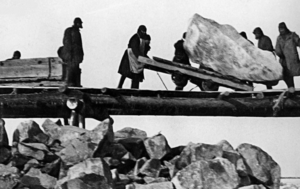Gulag facts for kids
Gulag describes a vast network of slave labor camps operated by the Soviet Union from the 1930s to the 1950s. Ever since the Soviet Union was founded in 1917, it imprisoned people who spoke out against it. This was in fact no different from what Imperial Russia did in previous decades, with its katorga camps. But the Soviet Union camp system eventually grew to be one of the biggest prison systems in existence.
Background
During the 1920s, the Soviet Union imprisoned more and more people that disagreed with it. Its leaders believed it was better to put these people to work and make their labor and goods part of the national economy. In fact, two out of every hundred workers in the Soviet Union were gulag prisoners.
The Gulag system was officially created in 1930. During the 1930s there was a lot of fear of the Soviet government. Police officials were encouraged to round up and imprison many citizens for the most trivial offenses, even if they were innocent, and this caused the Gulag system to swell. By 1936, there were 5,000,000 prisoners in the gulags.
Location
Even though the Gulag is often associated with Siberia, labor camps were located across the Soviet Union. Siberian camps greatly simplified the problem of keeping prisoners from running away, though it was harder to feed these camps and move goods in and out because the camps were so far away.
Decline and legacy
The Gulag system died during the 1950s after the death of Joseph Stalin, and many people were released starting in 1954. The Gulag program was ended with a government decree in 1960.
According to the Gulag administration, 10 million people were sent to the gulags between 1934 and 1947. However, Western scholars estimate that between 1918 and 1956, 15,000,000 to 30,000,000 people died in the gulags.
Images for kids
-
Genrikh Yagoda (middle) inspecting the construction of the Moscow-Volga canal. Behind his right shoulder is a young Nikita Khrushchev.
-
Group of prisoners in Sakhalin, remote prison island, c. 1903
-
Central shop in Norilsk built by prisoners of the Norillag
-
Part of 'Project 503' to build a railroad from Salekhard to Igarka near Turukhansk on the Yenisey
-
OGPU chiefs responsible for construction of the White Sea–Baltic Canal: right: Frenkel; center: Berman; left: Afanasev (Head of the southern part of BelBaltLag)
-
Memorial in St. Petersburg
-
Gulag Museum in Moscow, founded in 2001 by historian Anton Antonov-Ovseyenko
See also
 In Spanish: Gulag para niños
In Spanish: Gulag para niños






















